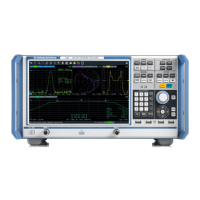Concepts and Features
R&S
®
ZNB/ZNBT
228User Manual 1173.9163.02 ─ 53
Limitations
●
With two internal sources the physical VNA ports are split into groups P1 and P2
such that source 1 can only drive ports in P1 and source 2 can only drive ports in
P2:
– P1 = {1,2} and P2 = {3,4} for a four-port R&S ZNB
– P1 = {1,...,8} and P2 = {9,...,24} for the R&S ZNBT
Independent signals require the source ports to reside in different port groups. On
the R&S ZNB, for example, you cannot use ports 1 and 2 as independent source
ports. A R&S ZNBT on the other hand must be equipped with at least 12 ports to
allow independent signals.
●
Operation with Internal Second Source is not supported, if External Switch Matri-
ces are part of the RF connection configuration.
5.7.9 Precision Frequency Reference
Option R&S ZNB/ZNBT-B4
An optional OCXO improves the static frequency accuracy of the R&S ZNB/ZNBT. For
details, refer to the data sheet.
5.7.10 GPIB Interface
Option R&S ZNB/ZNBT-B10
This hardware option provides a GPIB bus connector according to standard IEEE 488 /
IEC 625 (GPIB). The GPIB bus interface can be used for controlling the R&S ZNB/
ZNBT from an external controller.
For interface details, refer to Chapter 11.3.3, "GPIB Interface", on page 1384.
Remote Control of External Devices via GPIB
The current hardware of the R&S ZNB/ZNBT-B10 does not support GPIB bus control-
ler mode, i.e. the B10 cannot be used to control external devices via GPIB.
If you want to use GPIB to control external devices from the R&S ZNB/ZNBT, you have
to use an additional USB-to-IEC/IEEE Adapter.
Optional Extensions and Accessories

